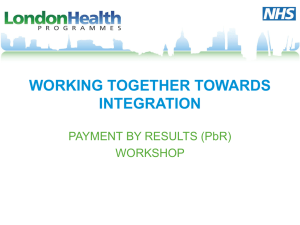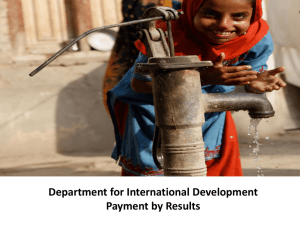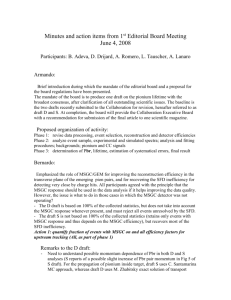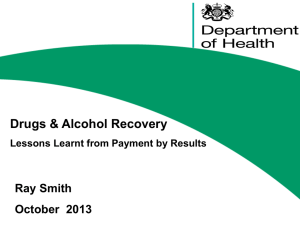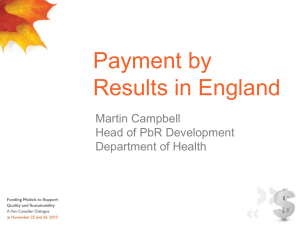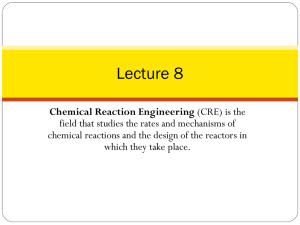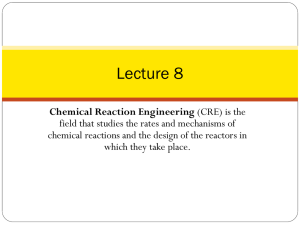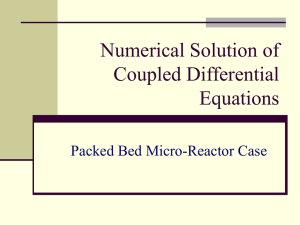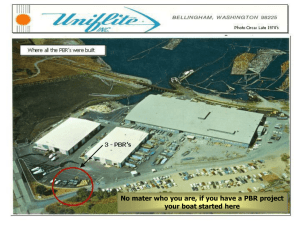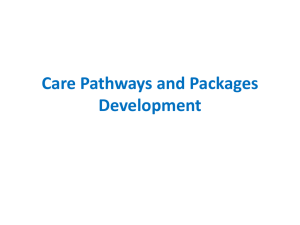Care Pathways & Packages Approach
advertisement
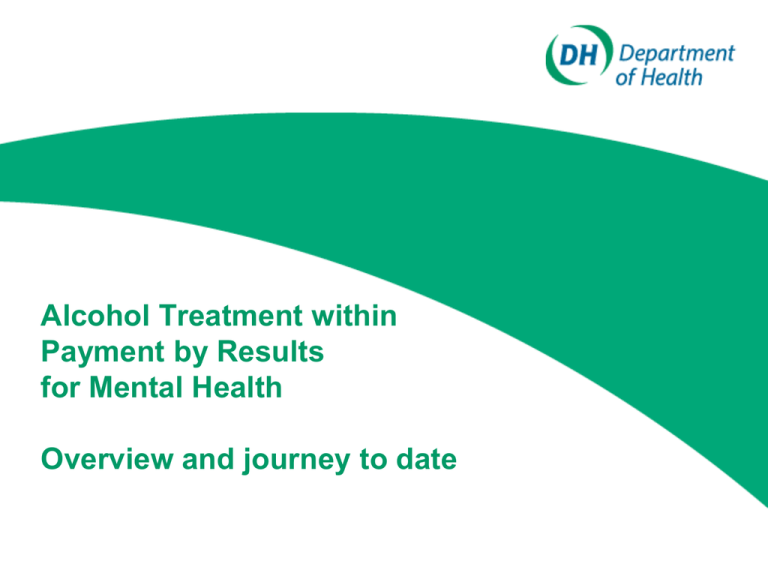
Alcohol Treatment within Payment by Results for Mental Health Overview and journey to date PbR Models – so far Historic “Block” Contracts Activity based PbR Outcome based PbR •How NHS hospital were funded •How NHS Acute Trusts funded today •Transfers risk to providers •Historical costs •Health Resource Groups (HRGs) •Experimental •Tariffs •Prisons •PROMs •Work Programme •Local NHS ‘family’ & budgets •Recovery PbR •Immigration 2 History of PbR in the NHS • 2003 - PbR introduced into NHS acute sector. A move away from sweeping block contracts towards payment for activity delivered • 2005 - Mental Health started work on PbR – but restricted work to main-stream adult mental health services • 2010 – programme began to include alcohol treatment within PbR for Mental Health (most NHS Mental Health Trusts deliver alcohol treatment along with voluntary sector agencies – mixed economy) • 2013 - commissioning of alcohol treatment services will transfer to LAs – PbR paused to not complicate transition 3 Mental Health Clusters Working – aged Adults and Older People with Mental Health Problems A Non Psychotic a Mild/ Mod/ Severe b Very Severe & Complex 1 2 3 4 5 6 7 8 B Psychotic Blank place marker 9 a First Episode 10 11 b On-going or recurrent 12 13 C Organic c Psychotic crisis 14 15 16 d Very Severe Engageme nt 17 18 a Cognitive Impairment 19 20 4 21 Alcohol Clusters • ‘Filling-in’ Mental Health PbR Cluster 9 • Need to assess – Level of dependence + – Level of health and social functioning or disability 5 Products needed for PbR 1. CLUSTERING TOOL – A method to assign individuals into needs based clusters (= to Health Resource Groups) 2. PACKAGES OF CARE - Needs-based packages of care that are evidence based and cost effective 3. OUTCOME MEASURES – Assess the progress and effectiveness of treatment 4. MINIMUM DATA SET - Captures • Assessment / Clusters • Treatment journey • Outcomes 5. COST REPORTING TOOLS - Capture costs for treating each cluster to inform local tariff setting 6 Alcohol development process • DH convened a Steering Group (from October 2010) – Royal Colleges – Professional bodies – Membership organisations and – other government departments • DH advised by an Expert Group (from November 2010) – Psychiatrists – Nurses – Commissioners – Data managers; and – Senior managers from services, – NHS – Voluntary sector 7 Alcohol development process • Pilot areas invited to test products (invited July 2011) – Middlesbrough – Nottingham – Rotherham; and – Wakefield • All progress reported to Mental Health PbR Product Review Group 8 4 Alcohol Clusters Alcohol Harm Clusters Dependence Health Needs HoNOS / SARN scales Social Needs HoNOS / SARN scales 1. Harmful & Mild Dependence AUDIT 16+ SADQ <15 Units/day <15 2. Moderate Dependence AUDIT 20+ SADQ 16-30 Units/day >15 3. Severe Dependence AUDIT 20+ SADQ >30 Units/day >30 4. Moderate & Severe + Complex Need AUDIT 20+ SADQ >15 Units/day >15 2. Non-accidental selfinjury 3. Problem-drinking or drug-taking 4. Cognitive problems 5. Physical Illness 6. Hallucinations and delusions 7. Depressed Mood 8. Other Symptoms A. Agitated behaviour (historical) B. Repeat self-harm (historical) 1. Aggressive behaviour 9. Relationships 10. Activities of Daily Living 11. Living Conditions 12. Occupation and Activities 13. Strong unreasonable beliefs C. Safeguarding children D. Engagement E. Vulnerability 9 Clustering Tool – Cluster 1 10 Clusters under development for: Alcohol harm and the need for Specialist Alcohol Treatment Primary Issue of alcohol misuse A 1 A 2 A 3 A 4 11 Relationship between MH and alcohol clusters 12 Packages of Care • NICE guidance defines these packages (http://guidance.nice.org.uk/CG115) • NICE - STOP looking at care - service by service – Detox, Residential Rehab, Day Treatment; etc • NICE - START looking at packages / stages of care: – Assessment & engagement – Care planning & case management – Withdrawal management – Addressing physical and psychiatric co-morbidity – Psychosocial interventions – Pharmacotherapy – Recovery, aftercare & reintegration 13 NICE Package of care: Moderate / Severe dependence with complex needs (Cluster 4) • • • • • • • Assessment / Engagement / Motivational enhancement: – Use AUDIT, SADQ/LDQ and units per day to determine dependence – Determine level of risk and the presence of co-existing problems recorded by use of HONOS/SARN – In-depth medical (physical & psychiatric) assessment will be necessary – Deliver motivational enhancement to promote engagement Care Planning / Care co-ordination and Case management: – A care plan – Case management lasting at least 12 months (frequent appointments in the first 6 months) Withdrawal management: – Most likely inpatient care (but upon assessment may be met through outpatient care) – Post withdrawal assessment of mental health issues and cognitive function Psychosocial interventions: – A package of 12 weeks of CBT (based in a day treatment programme) – Residential rehabilitation of up to 12 weeks may be required Pharmacotherapy: – For relapse prevention - acamprosate or naltrexone (or disulfiram if indicated) for one year. – This should be delivered in conjunction with psychosocial interventions Physical and Psychiatric co-morbidity: These should be managed according to appropriate NICE guidelines Recovery / Aftercare / Reintegration: Encouragement should be given to engage in self-help groups such as AA or SMART Recovery. Referral to employment services, assistance with housing and benefits may be required. 14 Challenges to services • • • • • Assessment / Engagement / Motivational enhancement: – Training in the use of HoNOS / SARN – Interpreting scores & assigning to “clusters” Care Planning / Care co-ordination and Case management: – Providing case management for up to a year Withdrawal management: – “For mild to moderate dependence and complex needs, or severe dependence, offer an intensive community programme following assisted withdrawal in which the service user may attend a day programme lasting between 4 and 7 days per week over a 3-week period.” (NICE Guidance) Psychosocial interventions: – Providing CBT in a consistent “manual based” way – Delivering 12 week packages of CBT Pharmacotherapy: – Providing acamprosate or naltrexone (or disulfiram if indicated) for up to a year 15 Outcome monitoring • Outcome monitoring is important in assessing how treatment for alcohol misuse is progressing • The main aim is to assess whether there has been a change in the targeted behaviour following treatment • Outcome monitoring aids in deciding whether treatment should: – be continued, or – a change of the care plan is needed • Routine outcome monitoring (including feedback to staff and patients) has been shown to be effective in improving outcomes NICE Guidance 16 Outcome monitoring • There is no consensus in the alcohol treatment field as to which tool is best to use • There are a number of existing tools that may be suitable including: – Comprehensive Drinker Profile – Addiction Severity Index – MAP – RESULT – Christo Inventory for Substance Misuse Services (CISS) – TOP – The Alcohol Star – ATOM – HoNOS – APQ – AUDIT 17 Outcome monitoring • Alcohol Treatment PbR Pilots tested: – AUDIT – O (Outcome) • 3 month recall period – ‘Alcohol’ TOP • Removed – harm reduction section – crime section • Kept – Alcohol & drug use – Health and social functioning • Performance of both still being assessed 18 Reporting costs • NHS Mental Health Trusts now reporting “costs by cluster” – the cost of treating an individual in the cluster • Alcohol Treatment PbR Pilots investigating ways to report “costs by cluster” • Methods developed by pilots will be made available for others to use 19 Usual PbR Next Steps Action Year 1 Currencies (clusters) announced Year 2 Currencies available for use Patients assigned a cluster Year 3 Report reference costs based on clusters Year 4 Clusters inform local indicative tariffs 20 PbR Status • From April 2013, local authorities have new public health responsibilities – Alcohol prevention and treatment services • Introducing PbR at this time might not be helpful – Need to allow LAs to settle – Need to assess how PbR can support the system • Will use this time to refine tools and products – Refine clustering tools – Review outcome data PbR Purpose • More productive discussions between commissioners and providers • Bench-marking (for both providers and commissioners) • Greater investment in proven interventions • Better care leading to better outcomes for service users 22 Drug and Alcohol Recovery PbR • • Next evolution of PbR - payment by OUTCOMES Outcomes for payment – Free from drug(s) of dependence • Interim - Drug and/or alcohol use significantly improved – Abstinent from all presenting substances – Planned exit from the treatment • Final - Discharged from treatment successfully (free of drug(s) of dependence) and do not re-present in either the treatment system or in the criminal justice system – Offending • Interim - No proven offending in a 6 month • Final - No proven offending in a 12 month period after discharge – Health and Wellbeing – Interim Outcomes • Injecting - reported 0 days injecting on any two TOP review • Hep B Vac - completed a course of Hepatitis B vaccinations • Housing - no longer had housing problem on any two review TOP • Wellbeing – improved quality of life score in any two TOP review 23 Drug and Alcohol Recovery PbR • Payment Modelling Tool - Complexity Index – NDTMS / NATMS – TOP data • Groups (based on likelihood of a good outcome) – Drugs: 5 groups – Alcohol: 3 groups – low, medium, high • Payments for (by local determination) – Abstinence – Reliable Change Index (RCI) – Treatment Completion – Housing – Re-presentation to treatment – Improvement in Quality of Life – Attachment fee 24 Drug and Alcohol Recovery PbR • Eight pilot areas testing out principles – Local design • Evaluation of pilots underway – Report in 2015 25
